2024 marks a turning point for the adoption of onchain finance in traditional markets, with Chainlink solidifying its position as the standard for verifiable data, cross-chain interoperability, and connectivity between blockchains and legacy infrastructure. This year featured several groundbreaking Chainlink product launches, solutions with some of the largest financial institutions and market infrastructures in the world, continued dominance across DeFi, substantial growth in key Chainlink programs such as Build and Scale, and much more.
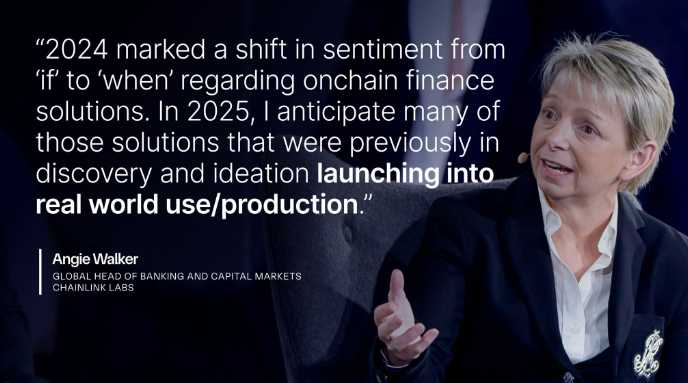
For a list of Chainlink’s biggest banking and capital markets announcements, check out the blog: Chainlink’s Work With Swift, Euroclear, and Major Banking and Capital Markets Institutions.
Dominance in Banking and Capital Markets
Chainlink, Euroclear, Swift, and 6 Financial Institutions Launch AI Initiative
The industry initiative brought together Chainlink, leading financial and market infrastructures Euroclear and Swift, and some of the world’s largest financial institutions, including UBS, Franklin Templeton, Wellington Management, CACEIS, Vontobel, and Sygnum Bank to “solve a 3.1 trillion dollar unstructured data problem”.
The initiative successfully demonstrated how LLMs can be used in combination with Chainlink for near real-time data distribution of corporate actions events across three blockchain networks. Financial institutions could then use that onchain corporate actions data to build automated and programmatic workflows for increased efficiency and new product opportunities. For more information, read the full report.
DTCC Announces Launch of Smart NAV To Accelerate Fund Tokenization With Chainlink, JP Morgan, Franklin Templeton, And More
Processing $2+ quadrillion annually, The Depository Trust and Clearing Corporation (DTCC) is the premier post-trade market infrastructure that provides clearing, settlement, asset servicing, data management, and trade reporting around millions of security transactions each day.
The DTCC, Chainlink, and 10 of the world’s largest financial institutions, including American Trust Custody, American Century Investments, BNY Mellon, Edward Jones, Franklin Templeton, Invesco, JP Morgan, MFS, State Street, and U.S. Bank collaborated on Smart NAV to deliver key mutual fund data onchain. Smart NAV demonstrated how DTCC and Chainlink can make net asset value (NAV) data available across virtually any private/public blockchain, enabling automated data dissemination and historical data access, which unlocks a multitude of use cases around fund tokenization.
One of the key findings from the report showed how Chainlink CCIP serves as an open blockchain interoperability standard to prevent future fragmentation by providing a secure abstraction layer between DTCC and blockchains.
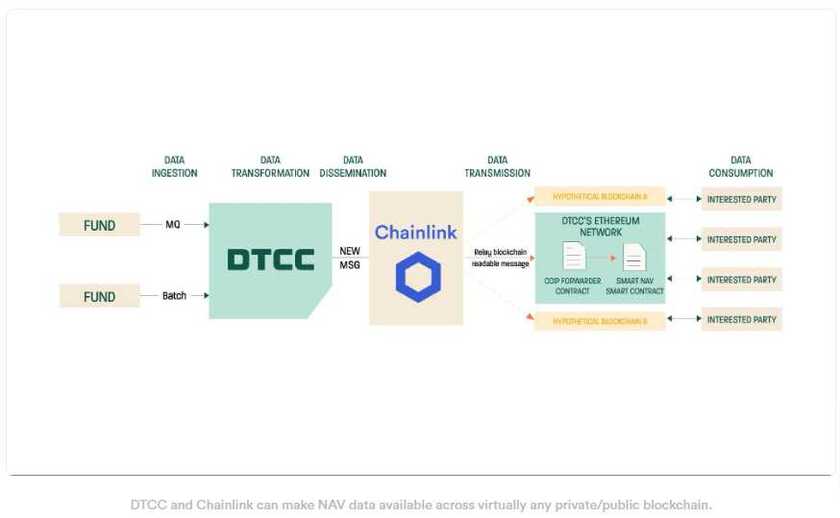
SBI Digital Markets, UBS Asset Management, and Chainlink Unlock Automated Fund Administration and Transfer Agency
SBI Digital Markets, UBS Asset Management, and Chainlink successfully completed their implementation of a tokenized fund, showcasing how tokenization, smart contracts, and Chainlink infrastructure can automate the fund management process for traditional fund administrators and transfer agents. This unlocks a fundamental shift in how the industry’s $132T global assets under management can begin to operate using blockchains.
The adoption of tokenized funds by the world’s largest asset managers has created a need for the fund administration industry to evolve into an onchain format. The UBS, SBIDM, and Chainlink solution shows how existing fund administration processes can apply to tokenized funds across multiple chains. The key insight is that existing systems already widely in use for fund administration processes can become compatible with tokenized funds once they’re made compatible with blockchains and smart contracts via Chainlink.
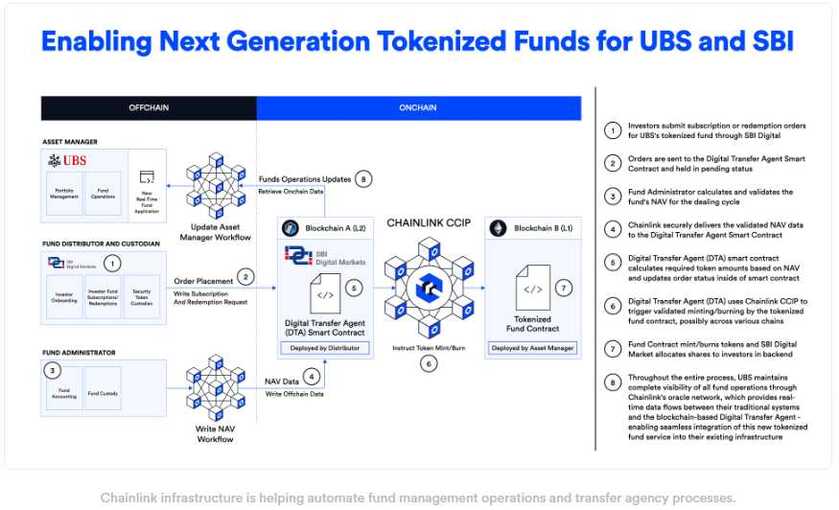
Swift, UBS Asset Management, and Chainlink Bridge Tokenized Assets With Existing Payment Systems
Swift, UBS Asset Management, and Chainlink successfully settled tokenized fund subscriptions and redemptions using the Swift network. This initiative enables digital asset transactions to settle offchain in fiat using an established payment system that’s already widely adopted by more than 11,500 financial institutions, across over 200 countries and territories.
“Our work with UBS Asset Management and Chainlink in MAS’ Project Guardian leverages the global Swift network to bridge digital assets with established systems.”—Jonathan Ehrenfeld, Head of Strategy at Swift
Swift, UBS, and Chainlink’s work proves how financial institutions can leverage blockchain technology, the Chainlink Platform, and the Swift network to settle subscriptions and redemptions for tokenized investment fund vehicles, thereby allowing the straight-through-processing of the payment leg without the need for global adoption of an onchain form of payment. This helps in the automation of the entire lifecycle of the fund redemption and subscription process.
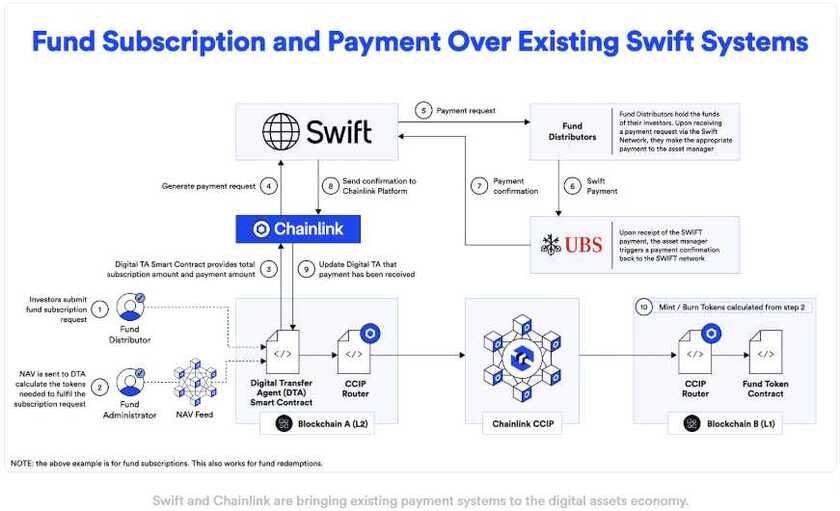
Central Bank of Brazil Selects Chainlink Alongside Banco Inter, Microsoft Brazil, and 7COMm To Build CBDC Solution for Trade Finance
The Central Bank of Brazil (BCB) selected Banco Inter alongside Microsoft Brazil, 7COMm, and Chainlink to build a trade finance solution as part of the second phase of Brazil’s DREX—Brazil’s digital currency pilot. The solution leverages blockchain technology and the Chainlink standard to automate supply chain management and improve trade finance processes. The goal of the solution is to demonstrate the automated settlement of agricultural commodity transactions across borders, across platforms, and via different currencies.
Chainlink CCIP enables interoperability between the Central Bank of Brazil and another country’s central bank. This unlocks real-world use cases, including international agricultural commodity trade, infrastructure development, and more.
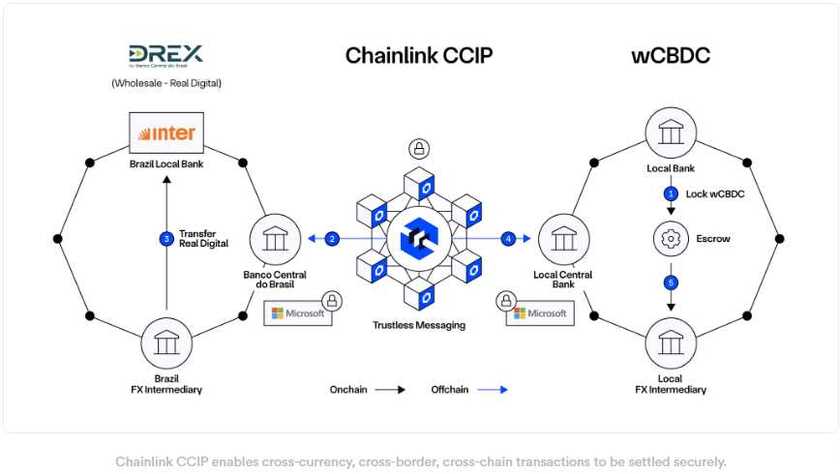
Fidelity International and Sygnum Partner With Chainlink To Bring NAV Data Onchain for Fidelity International’s $6.9 Billion Institutional Liquidity Fund
Fidelity International and Sygnum partnered with Chainlink to bring NAV data onchain for Fidelity International’s $6.9 billion Institutional Liquidity Fund. The solution provides unparalleled transparency and accessibility around key asset data for Fidelity International’s Institutional Liquidity Fund issued onchain by Sygnum.
Sygnum, a global digital asset banking group, tokenized $50 million of Matter Labs’ company treasury reserves (held in Fidelity’s International money market fund) and issued it as a token on the ZKsync blockchain (a Chainlink Scale partner).
“This is an important milestone, and it’s exciting to see the great work that’s been done with Fidelity International, Chainlink, and Matter Labs come to fruition, and we look forward to keep building an onchain ecosystem in a regulated and compliant way.”—Fatmire Bekiri, Head of Tokenization at Sygnum
ANZ Is Among the First Financial Institutions To Leverage CCIP Private Transactions for Cross-Chain Settlement of Tokenized RWAs
Chainlink CCIP Private Transactions enable confidential cross-chain transfers between private blockchain networks using the public CCIP network. CCIP Private Transactions feature a novel onchain encryption and decryption protocol, which empowers institutional cross-chain transactions across multiple private chains while keeping the transaction details including data, token amounts, and counterparties entirely private.
ANZ—an Australian bank with over A$1 trillion in AUM—is among the first financial institutions leveraging this capability for cross-chain settlement of tokenized real-world assets (RWAs) under the Monetary Authority of Singapore (MAS) Project Guardian initiative.
“Chainlink’s new cross-chain privacy capabilities have the potential to further accelerate institutional blockchain adoption by enabling end-to-end privacy between blockchain networks.”—Nigel Dobson, Banking Services Lead at ANZ
ADDX, ANZ, and Chainlink Introduce Privacy-Enabled Cross-Chain, Cross-Border Connectivity for Tokenized Commercial Paper
ADDX, in collaboration with ANZ and Chainlink, presented a solution focused on the entire asset lifecycle of tokenized commercial paper for cross-border transactions. The solution leverages ADDX’s investment platform, ANZ’s Digital Asset Services, and Chainlink’s Cross-Chain Interoperability Protocol (CCIP), including its recently announced Private Transactions capability.
“By leveraging Chainlink CCIP for secure and compliant blockchain interoperability, this use case showcases the utility of tokenized financial assets within a regulated environment.”—Inmoo Hwang, Co-Founder and Group CFO at ADDX
For this solution, the participants selected commercial paper as the candidate asset class. The short duration of the commercial paper makes it possible to showcase the entire asset lifecycle, from issuance and subscription to settlement and redemption. This transaction shows that regulated financial entities can securely tokenize and execute digital asset transactions using their existing systems while staying within the regulatory frameworks that ensure the integrity of financial markets.
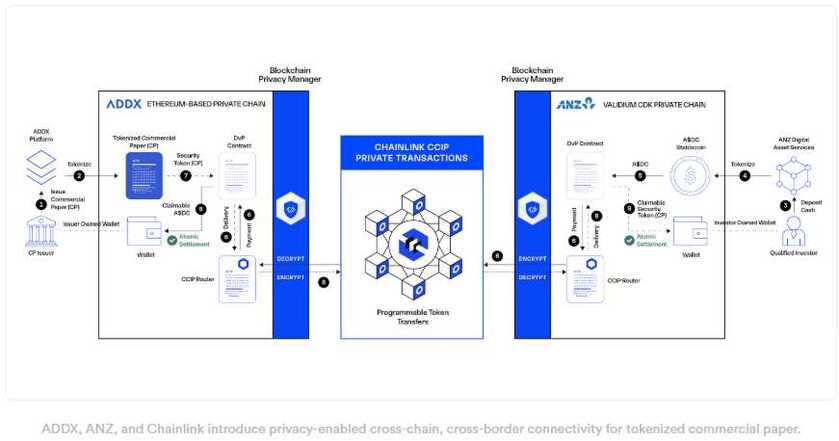
Bancolombia Group’s Wenia Taps Chainlink To Increase Transparency of Its Stablecoin Backed 1:1 By The Colombian Peso
Wenia—the new digital asset company from the Bancolombia Group, one of the largest financial conglomerates in Latin America—is live and in production using Chainlink Proof of Reserve (PoR) to bring end-to-end transparency to the Colombian Peso reserves backing its COPW stablecoin.
Through this collaboration, COPW users on the Wenia platform gain access to Chainlink’s secure and reliable onchain PoR data, enhancing visibility into the reserves backing the stablecoin. In addition, Chainlink PoR is integrated directly into the stablecoin’s minting function, helping to protect users against the risk of infinite mint attacks where additional COPW is issued without sufficient available reserves.
Growing Momentum in the Tokenized Asset Industry
$3T+ AUM Fund Administrator Apex Group Is Leveraging Chainlink Infrastructure for Tokenized Assets
$3T+ AUM fund administrator Apex Group is leveraging Chainlink’s infrastructure for tokenized assets. Apex Group and Chainlink are collaborating to help fund managers use CCIP, Data Feeds, and Proof of Reserve to enhance asset liquidity, utility, and transparency.
21Shares Leverages the Chainlink Standard to Increase Transparency for Bitcoin and Ethereum ETFs and 21BTC
Throughout 2024, 21Shares, an affiliate of 21.co, one of the world’s largest issuers of crypto exchange-traded products (ETPs), announced multiple integrations of the Chainlink standard.
- 21Shares integrated Chainlink Proof of Reserve to increase the transparency of the ARKB Bitcoin ETF, issued in collaboration with ARK Invest.
- 21Shares integrated Chainlink PoR to increase the transparency of the 21Shares Core Ethereum ETF (CETH).
- 21.co integrated Chainlink PoR to help verify reserves and secure minting for its wrapped Bitcoin product, 21BTC.
21X, Europe’s First Tokenized Securities Trading and Settlement System, Is Adopting the Chainlink Standard
Europe’s first tokenized securities trading and settlement system, 21X, is adopting the Chainlink standard. Chainlink Price Feeds will underpin 21X’s trading engine and CCIP will connect it to assets across the onchain economy.
21X, soon to launch the first EU-regulated financial market infrastructure (FMI) for order matching, trading, settlement, and registry services for tokenized money and securities, announced that it has signed a strategic partnership with Chainlink. Through this collaboration, 21X’s onchain trading, matching, and settlement system will leverage the Chainlink standard to enrich tokenized assets with high-quality data and facilitate cross-chain interoperability.
“We will launch 21X in Q1 2025 on a public permissionless blockchain and look forward to making a variety of tokenized assets accessible to our clients and prospects through CCIP. In addition, Chainlink will provide secure and accurate price data feeds for listed products on 21X.”—Max Heinzle, Founder and CEO of 21X
Coinbase’s Project Diamond Strategically Integrates the Chainlink Standard To Scale Institutional Adoption of Digital Assets
Coinbase’s Project Diamond—a compliant digital asset platform for global institutions—is adopting the Chainlink standard as infrastructure for powering the full lifecycle management of tokenized assets. With Chainlink natively integrated into the Project Diamond platform, asset issuers and fund managers have a secure and compliant solution to quickly scale their tokenized assets across public and private blockchains through verifiable data connectivity.
Chainlink CCIP is enabling new assets on Coinbase’s Project Diamond platform to become interoperable with public or private blockchains. Chainlink Functions enriches these assets with high-quality, real-world data, no matter which chain they move across via CCIP. The integration of the Chainlink standard will also enhance the existing Coinbase Project Diamond implementation for Abu Dhabi Global Market’s (ADGM) RegLab.
Emirates NBD welcomes Chainlink to Digital Asset Lab
Emirates NBD, a ~$260B AUM banking group in the Middle East, North Africa, and Türkiye (MENAT) region, announced Chainlink as the fifth member of its Digital Asset Lab. Chainlink will join other founding members, including PwC, Fireblocks, R3, and Chainalysis.
Chainlink’s membership will play a key role in advancing the Digital Asset Lab’s mission to create innovative solutions in digital finance. The Chainlink standard will help support the adoption of digital assets in the region via verifiable data and cross-chain interoperability.
“With Chainlink Labs’ expertise in onchain finance, we are confident this partnership will drive new advancements in tokenisation and digital asset management, reinforcing Emirates NBD’s position as a regional leader in financial innovation.”—Miguel Rio Tinto, Group Chief Digital and Information Officer at Emirates NBD
Chainlink Labs Establishes Presence in Abu Dhabi Global Market
Chainlink Labs announced that it is expanding its presence in the Middle East and North Africa (MENA) region, including setting up an office and establishing an entity in Abu Dhabi under the Registration Authority of ADGM.
Chainlink Labs plans to utilize its local presence to expand its network of strategic partnerships with financial market infrastructures and financial institutions, better serve its global ecosystem, and continue to build key relationships in the region as demand for tokenized assets surges.
Backed, Sonic, and Chainlink Partner with Fortlake Asset Management for Landmark Fund Tokenization Solution
Fortlake Asset Management—a fund manager backed by JP Morgan—is launching a tokenized fund on Sonic, which is facilitated by Backed and powered by the Chainlink standard. Chainlink CCIP and SmartData will be key drivers of the fund’s utility and adoption.
The fund is being tokenized by Backed, creating permissionless tokens that are collateralized 1 to 1 by fund units, with the price tied to the real-time net asset value (NAV). Chainlink SmartData will deliver NAV data of the underlying fund shares onchain, Chainlink Proof of Reserve will help verify collateralization and AUM, and Chainlink CCIP will enable seamless cross-chain liquidity and operations.
Fireblocks and Chainlink Labs Announce Strategic Collaboration To Accelerate Regulated Stablecoin Issuance
Fireblocks and Chainlink Labs have entered into a strategic collaboration to accelerate regulated stablecoin issuance. Fireblocks and Chainlink will provide a secure and compliant technology solution for banks and financial institutions to issue and transact with stablecoins across global financial markets.
The technology solution plans to support end-to-end tokenization capabilities for stablecoin issuers, including issuance, data synchronization, data connectivity and enrichment, compliance, custody, interoperability, and distribution. This integrated offering will give issuing agents a single, comprehensive, real-time view of stablecoins, reserves, market value, and total supply, including across different blockchains.
SOOHO.IO and Chainlink Announce Strategic Partnership To Explore Tokenized Asset and CBDC Use Cases in South Korea, Japan, Thailand, and Other Asian Markets
Blockchain financial technology company SOOHO.IO announced a strategic partnership with Chainlink to accelerate the development of tokenized assets and CBDC use cases in emerging digital markets across Asia, particularly in Korea, Japan, and Thailand.
The partnership will focus on utilizing Chainlink to support the adoption of blockchain technology by financial institutions, with a specific emphasis on leveraging Chainlink CCIP for cross-chain asset transfers, Chainlink Proof of Reserve for verification of prepaid settlement reserves, and Chainlink oracles for provisioning NAV data onchain.
“Chainlink has become the industry standard for tokenization use cases. This partnership will allow us to work extensively with Chainlink in the Asia region, addressing the needs of financial institutions and creating fundamental solutions for the digital asset industry.”—Jisoo Park, CEO of SOOHO.IO
Superstate Integrates Chainlink Infrastructure To Enhance the Transparency and Utility of the USTB Tokenized Fund
Superstate, an asset management firm modernizing investing through tokenized financial products, integrated Chainlink Data Feeds into its tokenized treasury fund—the Superstate Short Duration US Government Securities Fund (USTB). Specifically, Superstate integrated Chainlink for onchain NAV data to enhance the transparency and utility of USTB. Additionally, Superstate plans to integrate Chainlink Proof of Reserve to further enhance onchain verification of its AUM data.
The integration of Chainlink brings numerous benefits to USTB, including real-time transparency of its reserves, democratized access, and opportunities for the fund to be composable and programmable within collateralized lending, asset management, and market making.
Arta TechFin and Chainlink Labs Expand Digital Asset Collaboration in Hong Kong
Arta TechFin, a Hong Kong-based financial services platform, expanded its partnership with Chainlink Labs around fund tokenization. The ARTA-Chainlink solution aims to bring a wide variety of key asset data onchain and across different blockchains, helping meet the needs of asset owners and financial institutions in Hong Kong and abroad that are seeking greater levels of accessibility to the digital asset space for their clients. The partnership brings a much-needed market standard for originating, distributing, trading, and keeping custody of tokenized assets.
Extensive Adoption in DeFi
Scaling Lido and Other (Re)Staking Protocols Expand Cross-Chain via Chainlink CCIP
Lido, a leading liquid staking protocol, integrated CCIP to power the new Lido Direct Staking rails, enabling users to stake their ETH directly from other blockchain networks and receive wstETH, starting with support for Arbitrum, Base, and Optimism. The new Lido Direct Staking rails are being adopted by various DeFi frontends, including XSwap, OpenOcean, and Interport.
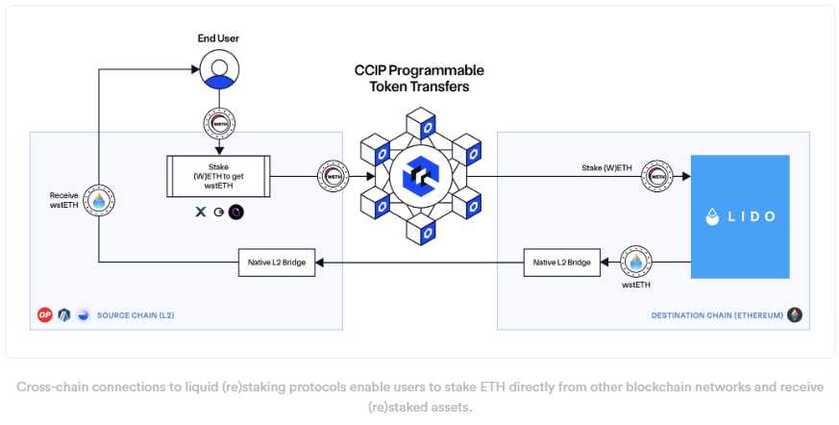
In addition to Lido, a growing number of protocols are also integrating Chainlink CCIP to go cross-chain and enable the staking/restaking of ETH from layer-2 networks:
- Diva (divETH)
- EigenPie (egETH)
- Frax (sfrxETH)
- Gravita (gravETH)
- Origin (oETH)
- StakeStone (STONE)
- Vaultcraft (wstETH)
For more information on how CCIP is helping (re)staking protocols scale, read the full announcement blog: Scaling (Re)Staking Protocols Cross-Chain With CCIP.
Donald Trump-Inspired World Liberty Financial Adopts the Chainlink Standard To Accelerate the Mass Adoption of DeFi
Trump-supported World Liberty Financial (WLFI) selected the Chainlink standard to support its planned launch of the World Liberty Financial Aave v3 instance. Chainlink Price Feeds will provide the WLFI Protocol with a secure and reliable source of financial market data, crucial to enabling lending/borrowing markets as part of WLFI’s Aave v3 instance.
Chainlink’s track record of successfully keeping Aave’s markets secure for over 5 years without losing user value was a main factor in WLFI choosing Chainlink. WFLI plans to leverage additional capabilities of Chainlink in the future, such as CCIP for cross-chain interoperability, Proof of Reserve for RWAs, and more.
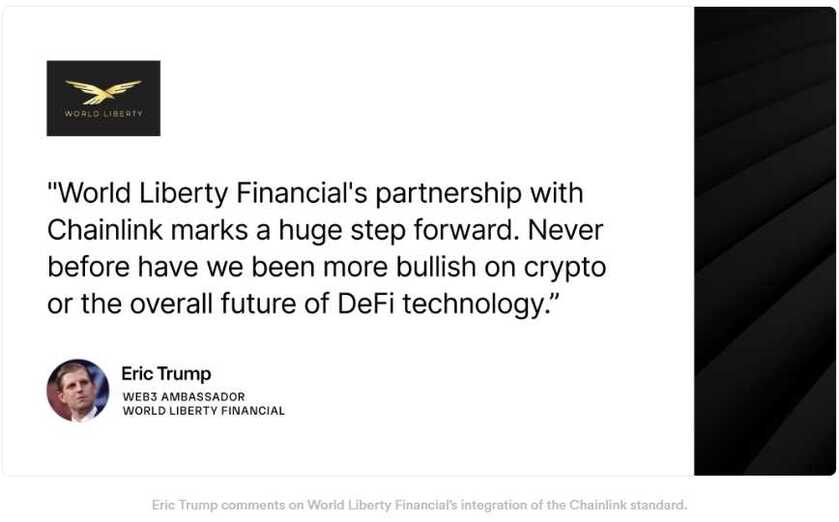
Aave’s GHO Stablecoin Goes Live on Arbitrum Powered by Chainlink CCIP
The Aave DAO launched its stablecoin GHO, the multi-collateralized stablecoin native to the Aave Protocol, on the Arbitrum network—marking the DAO’s first new market in its phased GHO cross-chain expansion strategy powered by CCIP.
For secure cross-chain transfers between Ethereum and non-Ethereum chains like Arbitrum, GHO uses a lock-and-mint model enabled by CCIP, in which tokens are locked on Ethereum while an equivalent amount is minted on the other network, keeping the total supply constant. Transfers between non-Ethereum chains will use a burn-and-mint model enabled by CCIP for maximum capital efficiency and fungibility while still being backed by reserves on Ethereum. This ensures security and flexibility for GHO’s future expansion across multiple blockchains.
Telefónica Integrates Chainlink Functions To Help Smart Contracts Detect Unauthorized SIM Card Changes
Telefónica, a Spanish multinational telecommunications company, leveraged Chainlink Functions to enable developers to connect any API on the GSMA Open Gateway to the Polygon blockchain. GSMA Open Gateway is a global telecoms industry initiative led by the GSMA, which introduced a suite of standardized Telco APIs that bring pioneering Telco capabilities to the Web3 ecosystem.
The first GSMA Open Gateway API, SIM SWAP—introduced in Brazil by the carrier Vivo (Telefónica Brazil)—is leveraging Chainlink Functions to enable the verification of data from various sources. This integration not only enhances transaction security but also introduces an extra layer of security to blockchain transactions by enabling smart contracts to make information requests to the API to ensure that a device’s SIM card has not undergone any unauthorized changes. Using the GSMA Open Gateway API via Chainlink can also help mitigate risk beyond transaction security, addressing two-factor authentication (2FA) and fraud detection in Web3 apps and DeFi services.
BTCFi Ecosystem Increasingly Adopting the Chainlink Standard
Solv Protocol, one of the largest Bitcoin staking platforms, is adopting the Chainlink standard for data and cross-chain solutions. Solv integrated Chainlink CCIP across the Arbitrum, Avalanche, BNB Chain, and Ethereum mainnets to facilitate cross-chain transfers of SolvBTC, SolvBTC.BBN, and SolvBTC.ENA. Solv is also integrating Chainlink Price Feeds and Proof of Reserve to enhance the liquidity, utility, and transparency of its tokenized assets.
“A secure BTCFi ecosystem needs robust and battle-tested infrastructure, which is why integrating Chainlink was an obvious choice.”–Ryan Chow, Solv Protocol Founder
Solv is one of many BTCFi projects adopting the Chainlink standard. Others include: 21BTC, B2 Network, Babypie, Bedrock, Bitlayer, Botanix Labs, dlcBTC, FBTC, Lombard, Lorenzo, and PumpBTC.
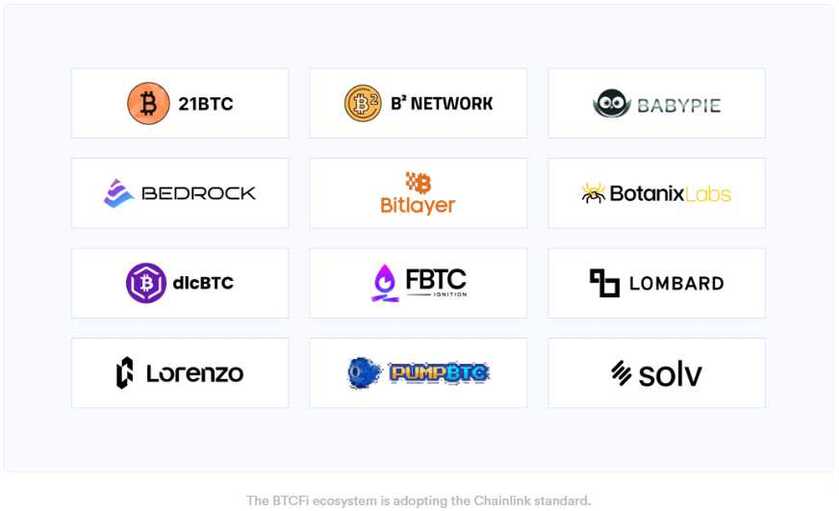
GMX-Solana Adopts Chainlink Data Streams As Official Data Oracle Solution on Solana
As part of the launch of Chainlink Data Streams on Solana, GMX-Solana—a community-driven sister project bringing the GMX V2 protocol to Solana—adopted Chainlink Data Streams as its official data oracle solution. Chainlink Data Streams help secure execution prices, funding rate calculations, liquidations, and other features on GMX-Solana that require secure, low-latency market data. As part of the integration, 1.2% of total protocol fees generated by GMX-Solana will be paid to Chainlink service providers in exchange for using Chainlink Data Streams.
“Since the initial launch of GMX V2 powered by Chainlink Data Streams, the low-latency oracle solution has enabled $64.84 billion in transaction volume for GMX. The success of this collaboration between the GMX and Chainlink communities made choosing Chainlink Data Streams as the oracle solution powering GMX-Solana an obvious choice.” —GMX-Solana
Key Chainlink Product Announcements in 2024
To get an in-depth look at all the product innovations in 2024, check the Chainlink Q1 Product Update, Q2 Product Update, and SmartCon Recap blogs. Below are the key highlights.
Chainlink Runtime Environment (CRE)
The Chainlink Runtime Environment (CRE) is a major upgrade to the Chainlink Platform, designed to scale Chainlink across thousands of blockchains, meet the growing demand from financial institutions, and empower developers to build with Chainlink faster, more easily, and with more reach and flexibility than ever before.
Underpinning this initiative is a deep re-architecture of the Chainlink Platform. Drawing inspiration from microservices architecture, the Chainlink node software utilized by decentralized oracle networks (DONs) is being broken down into distinct, modular capabilities (e.g., read chain, perform consensus, etc.) that are each secured by independent DONs. Developers can seamlessly combine these capabilities in any number of ways into executable workflows that run via the newly developed Chainlink Runtime Environment (CRE)—the system of DON-based capabilities, DON-to-DON communications, capability orchestration, and code execution on which workflows run with the appropriate consensus model.

Read the full announcement blog post to learn more about how CRE will enable more purpose-built financial apps for capital markets.
Chainlink CCIP Enters General Availability, Launched Cross-Chain Token (CCT) Standard, and Supported Numerous New Features
Chainlink CCIP entered general availability (GA), meaning any developer can permissionlessly use CCIP to securely transfer onboarded tokens cross-chain, send arbitrary messages to smart contracts on another integrated blockchain, or simultaneously send data and value together through CCIP’s unique support for Programmable Token Transfers.
CCIP also introduced the Cross-Chain Token (CCT) standard, which are cross-chain native tokens secured by CCIP. CCTs support self-serve deployments, full control and ownership for developers, enhanced programmability, and zero-slippage transfers—all backed by CCIP’s industry-standard defense-in-depth security. Notably, CCTs do not require token developers to inherit any CCIP-specific code within their token’s smart contract.

CCIP also introduced a variety of new features such as:
- Lock and Unlock Support—A new token transfer mechanism, which complements the existing “burn and mint” and “lock and mint” methods of transfer.
- Updated pricing model—CCIP is now one of the most cost-efficient options for securely and reliably transferring a wide range of tokens and messages cross-chain.
- CCIP Local Simulator—The CCIP Local Simulator enables developers to quickly build and iterate on their cross-chain dApps, reducing CCIP message and token transfer times during the building phase from 10+ minutes to less than a second. You can install and start building using the CCIP Local Simulator today by visiting the Chainlink GitHub.
- Transporter—A hyper-secure and intuitive bridging app built in association with the Chainlink Foundation, with support from Chainlink Labs. Transporter enables anyone to easily and securely transfer their token cross-chain via CCIP. Start using Transporter today.
- Token Developer Attestation—Token developers will be able to add additional external verifiers to their CCTs, enabling them to participate in the cross-chain verification process of their tokens.
- CCIP Token Manager—A new intuitive front-end web interface for token developers to seamlessly register, configure, and manage CCTs and token pools across multiple blockchain networks, including no-code, guided token deployments.
- CCIP SDK—A new software development kit that streamlines the process of integrating CCIP by allowing developers to use JavaScript to create a token transfer frontend dApp.
- Refreshed CCIP Explorer—A new, unified design and improved navigation of the CCIP Explorer makes for a more seamless and intuitive developer experience.
Chainlink Platform Privacy Suite: Blockchain Privacy Manager, CCIP Private Transactions, and DECO Sandbox
Chainlink further innovated on a suite of privacy solutions that solve different privacy concerns for institutions and Web3 developers.
- The Blockchain Privacy Manager for privacy of data entering and leaving blockchains: The Blockchain Privacy Manager enables institutions to integrate the public Chainlink Platform and their existing systems with private blockchain networks while limiting onchain data exposure.
- CCIP Private Transactions for privacy of cross-chain transactions: CCIP Private Transactions leverages the Blockchain Privacy Manager and a novel onchain encryption/decryption protocol to enable institutions to transact across multiple private blockchains using the public CCIP network, while keeping the transaction details fully confidential.
- DECO for privacy for onchain data: DECO enables statements about offchain data to be shared onchain without revealing the underlying data. The Chainlink DECO Sandbox has been opened to the public, providing developers with access to DECO, the foundational zkTLS-oracle technology for authenticating and verifying web data in a privacy-preserving manner.

If your organization is interested in adopting the Blockchain Privacy Manager and/or CCIP Private Transactions, reach out to an expert below.
Chainlink Digital Assets Sandbox
The Chainlink Digital Assets Sandbox (DAS) was launched to accelerate digital asset innovation within financial institutions. With the DAS alongside expert support and consultancy services provided by Chainlink Labs, financial institutions can now go from the start of their digital asset journey to having completed a successful PoC in days, not months, saving them not only time and resources but also realizing business impact much faster.
The Chainlink DAS provides institutions with access to ready-to-use business workflows for digital assets. For example, institutions can use the Chainlink DAS across multiple blockchain testnets to digitize a traditional bond by converting it into digital tokens and enabling these tokens to be traded and settled on a Delivery versus Payment (DvP) basis, along with many other real-world examples involving a variety of financial instruments across their entire life cycles.

Smart Value Recapture (SVR): A Chainlink-Powered MEV Recapture Solution For DeFi
Chainlink introduced Smart Value Recapture (SVR) —a novel oracle solution designed to enable DeFi applications to recapture the non-toxic Maximal Extractable Value (MEV) derived from their use of Chainlink Price Feeds. The initial version of Chainlink SVR was built in collaboration with BGD Labs, Flashbots, and other contributors to the Aave DAO and will initially focus on enabling DeFi lending protocols to recapture oracle-related MEV from liquidations.
Built on top of Chainlink infrastructure, SVR systematically reduces unnecessary third-party dependencies and eliminates the need to integrate intermediary smart contracts, making it a very minimal lift for existing Chainlink Price Feed users to adopt SVR. The value recaptured by SVR not only provides DeFi protocols with a new revenue stream, but can be used to promote the long-term economic sustainability of Chainlink oracles, ultimately ensuring DeFi protocols maintain access to highly secure and reliable oracles. The integration of Chainlink SVR by the Aave community is currently undergoing governance approval and can be read on the Aave forum.

Chainlink Automation 2.0
Chainlink Automation 2.0 launched in production, enabling developers to offload any smart contract computation offchain in a verifiable and ultra-reliable manner. Chainlink Automation 2.0 allowed development teams to automate even the most intricate Web3 use cases, saving up to 90% in gas costs in the process.
Chainlink Automation is powered by decentralized and verifiable offchain computing with the highest standard of cryptographic guarantees. Automation 2.0 also features an expanded set of triggers, unlocking new ways to connect multiple dApps. For example, Automation now enables smart contracts to react to log events emitted onchain, acting as a powerful messaging bus that’s similar to the pub/sub messaging bus used to connect microservices in Web2.
Chainlink Ecosystem Moments in 2024
The Chainlink ecosystem has continued to gain dominance, with notable growth across several key metrics, including:
- $18.2T+ in transaction value enabled
- 15.7B+ total verified messages
- 7 new Chainlink Scale members (15+ total)
- 42 new Chainlink Build members (100+ total)
- 15 new canonical CCIP integrations
- 140 new Data Streams markets
- 150 community events
- 18K+ hackathon signups and 378 submitted projects
- 30+ workshops

































